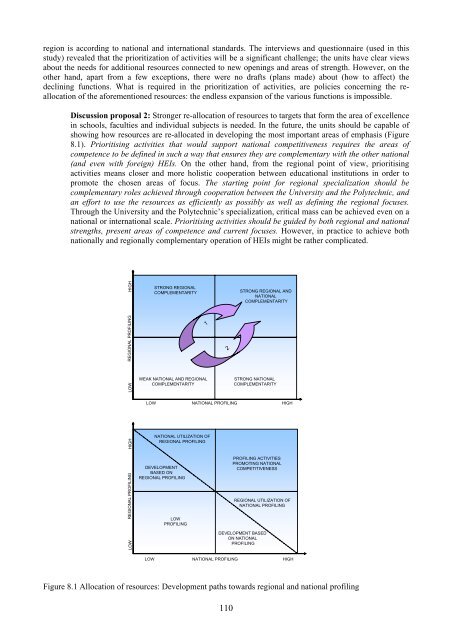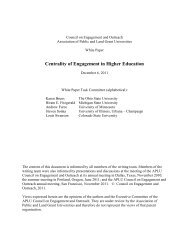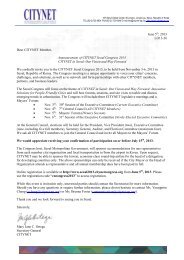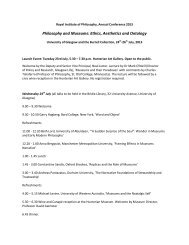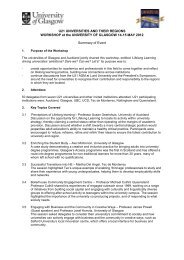VIII CONCLUSIONS: MOVING BEYOND THE SELF-EVALUATIONThe role of the University of Jyväskylä and Jyväskylä Polytechnic in regional development has a longhistory and cooperation with other bodies participating in development work in the Jyväskylä region is partof the operation of HEIs. However, there is a great challenge in terms of how regional effectiveness could befurther developed. The competition between the HEIs and the regions at the national level is hard, andbecoming stagnant is not an option. Continuous development work has to be done to maintain the advantageover other competitors. The Ministry of Education’s commission, designed to update the joint regionaldevelopment strategy of the region's HEIs, set yet another challenge for increasing regional effectiveness.The created strategy presents the tools by which the HEIs promote the welfare and competitiveness ofCentral <strong>Finland</strong> in the coming years, and which at the same time improve the position of the University ofJyväskylä and Jyväskylä Polytechnic in the national network of HEIs. The joint regional strategy of theUniversity of Jyväskylä and Jyväskylä Polytechnic was appreciated by the Ministry of Education <strong>Finland</strong> forthree reasons: (1) this OECD –project was positively used in the preparation of the strategy, (2) thedevelopment needs of the innovation environment are well analysed, and (3) the strategy aims to concretelycontribute to the cooperation between the University and Polytechnic 20 .8.1 General starting pointsContents of the regional development task are still under discussion. There is a lot of variation in theunderstandings of what regional effectiveness means and what the role of HEIs actually is, and, furthermore,what the regional development task should actually contain. To get common understanding of regionaldevelopment task is particularly challenging for the universities due to their strong national and internationalorientation. <strong>Region</strong>al effectiveness, or in a broader sense, a task of societal service, is easily perceived asbeing separate from the other basic tasks of HEIs. The third basic task of HEIs, which has already gainedground as a concept, has helped to guide opinions in this direction. The assumption presented above is justwhat it takes to make actors concerned about a possible shortage of resources and limitations to theirfreedom of action. Another concern is that their national role, in carrying out the basic tasks of education andresearch, weakens as well.Discussion proposal 1: <strong>Region</strong>al effectiveness should be seen as a field of tasks, solidly integratedwith the core HEI functions; education and research. In order to have real impact on the region, thepossibilities must be recognized and utilized effectively when carrying out these basic tasks. Withouta clear connection to education and research, regional development becomes nothing but hot air,with no real objective or chances of continuity. The intermediary organizational and expert servicesprovided by the HEIs should also be tightly connected to the chosen focuses of education andresearch.The relationships between the national and the regional focuses of the HEIs should be defined moreclearly in the future. The functions that have a strong national emphasis in the HEIs should not beused artificially to promote regional effectiveness. On the other hand, activities can have an effect onthe region only if they are nationally significant. Concretising the regional development task in thefaculties/departments and separate units of the University and the schools of the Polytechnic requiresthe contents to be clearly and concretely defined and goals to be set for regionaleffectiveness/regional development tasks, and the joint regional strategy. When drawing up thedefinitions, the complementary roles of the University and the Polytechnic should be taken intoaccount through the division of labour.The challenge of prioritizing activities. At the moment, the HEIs in Jyväskylä offer a wide range ofeducation, which, on the one hand, is a definite strength. The key factor in international competitiveness –excellence – is only achievable by prioritizing activities and by specialization in the areas of highestexpertise. Without sufficiently prioritizing activities, the possibilities for regional effectiveness are also leftunutilized because the regional effectiveness of HEIs is measured by how high the level of competence in the20 Based on Arvo Jäppinen’s seminar presentation (Ministry of Education) in Turku in 24.-25.11.2005.109
egion is according to national and international standards. The interviews and questionnaire (used in thisstudy) revealed that the prioritization of activities will be a significant challenge; the units have clear viewsabout the needs for additional resources connected to new openings and areas of strength. However, on theother hand, apart from a few exceptions, there were no drafts (plans made) about (how to affect) thedeclining functions. What is required in the prioritization of activities, are policies concerning the reallocationof the aforementioned resources: the endless expansion of the various functions is impossible.Discussion proposal 2: Stronger re-allocation of resources to targets that form the area of excellencein schools, faculties and individual subjects is needed. In the future, the units should be capable ofshowing how resources are re-allocated in developing the most important areas of emphasis (Figure8.1). Prioritising activities that would support national competitiveness requires the areas ofcompetence to be defined in such a way that ensures they are complementary with the other national(and even with foreign) HEIs. On the other hand, from the regional point of view, prioritisingactivities means closer and more holistic cooperation between educational institutions in order topromote the chosen areas of focus. The starting point for regional specialization should becomplementary roles achieved through cooperation between the University and the Polytechnic, andan effort to use the resources as efficiently as possibly as well as defining the regional focuses.Through the University and the Polytechnic’s specialization, critical mass can be achieved even on anational or international scale. Prioritising activities should be guided by both regional and nationalstrengths, present areas of competence and current focuses. However, in practice to achieve bothnationally and regionally complementary operation of HEIs might be rather complicated.LOW REGIONAL PROFILINGHIGHSTRONG REGIONALCOMPLEMENTARITY1WEAK NATIONAL AND REGIONALCOMPLEMENTARITY2STRONG REGIONAL ANDNATIONALCOMPLEMENTARITYSTRONG NATIONALCOMPLEMENTARITYLOWNATIONAL PROFILINGHIGHLOW REGIONAL PROFILINGHIGHNATIONAL UTILIZATION OFREGIONAL PROFILINGDEVELOPMENTBASED ONREGIONAL PROFILINGLOWPROFILINGPROFILING ACTIVITIESPROMOTING NATIONALCOMPETITIVENESSREGIONAL UTILIZATION OFNATIONAL PROFILINGDEVELOPMENT BASEDON NATIONALPROFILINGLOWNATIONAL PROFILINGHIGHFigure 8.1 Allocation of resources: Development paths towards regional and national profiling110
- Page 1 and 2:
OECD/IMHE ‐ Supporting thecontrib
- Page 3 and 4:
SUMMARYTogether with 13 other regio
- Page 5 and 6:
8.2 Increasing the regional effecti
- Page 7 and 8:
I INTRODUCTION1.1 Strengthening the
- Page 9 and 10:
development. The aim is that region
- Page 11 and 12:
The self-evaluation considered here
- Page 13 and 14:
densely populated cities in Finland
- Page 15 and 16:
1,9 %1,7 %1,5 %1,3 %Population chan
- Page 17 and 18:
The share of jobs in primary produc
- Page 19 and 20:
New pillars of future’s developme
- Page 21 and 22:
Jyväskylä0,60,91,11,0Central Finl
- Page 23 and 24:
2.4 Governance StructureMunicipalit
- Page 25 and 26:
of its development outside the cent
- Page 27 and 28:
III CHARACTERISTICS OF THE HIGHER E
- Page 29 and 30:
continuing education and open unive
- Page 31 and 32:
The Science and Technology Policy C
- Page 33 and 34:
3.2 Regional dimension within the n
- Page 35 and 36:
order to respond to the challenges
- Page 37 and 38:
14001200Master's degreesDoctoratesN
- Page 39 and 40:
900800Youth graduatedAdult graduate
- Page 41 and 42:
provide information for the basis o
- Page 43 and 44:
CabinetParliamentSTPCSteering (andf
- Page 45 and 46:
5,04,0Billion euros3,02,01,00,083 8
- Page 47 and 48:
The number of refereed articles is
- Page 49 and 50:
Centre of expertisePaper industryBi
- Page 51 and 52:
The Institute for Environmental Res
- Page 53 and 54:
and systematic gradually progressin
- Page 55 and 56:
are seen to be very important chann
- Page 57 and 58:
Internal support units of HEIsThe F
- Page 59 and 60: of interviewed HEI staffs, the coop
- Page 61 and 62: areas of the region’s Centre of E
- Page 63 and 64: system of Jyväskylä and the HEIs
- Page 65 and 66: V CONTRIBUTION OF TEACHING AND LEAR
- Page 67 and 68: esources to establish new activitie
- Page 69 and 70: The main problem for the Finnish la
- Page 71 and 72: longer. 2.5% of the Jyväskylä Pol
- Page 73 and 74: activities. As a part of the new qu
- Page 75 and 76: education programmes consisting of
- Page 77 and 78: the TE-Centre of Central Finland an
- Page 79 and 80: practices in the provision of educa
- Page 81 and 82: Reason forskillupgradingDescription
- Page 83 and 84: Strengths+ HEIs are actively confro
- Page 85 and 86: taxation, to lower the unemployment
- Page 87 and 88: Box 6.2 The WIRE -projects: Support
- Page 89 and 90: indoor ice-skating rink, the Rauhal
- Page 91 and 92: The School of Cultural Studies at t
- Page 93 and 94: the number of registered customers
- Page 95 and 96: Box 6.9 Environmental management in
- Page 97 and 98: Strengths+ The significance of HEIs
- Page 99 and 100: eferring to the regional developmen
- Page 101 and 102: Key topics relating to changes in t
- Page 103 and 104: participation in the decision makin
- Page 105 and 106: in the strategy-making process. The
- Page 107 and 108: 7.5 Critical points in promoting th
- Page 109: 7.Cooperation in strategies concern
- Page 113 and 114: oundaries for further developmental
- Page 115 and 116: joining resources and operations by
- Page 117 and 118: Discussion proposal 15: To ensure d
- Page 119 and 120: achieved by the horizontal utilizat
- Page 121 and 122: Appendix 2 Information on data used
- Page 123 and 124: and finding synergy between the oth
- Page 125 and 126: School of BusinessRoleThe School of
- Page 127 and 128: The challenge of the school from re
- Page 129 and 130: developing wellness and environment
- Page 131 and 132: Faculty of EducationRoleThe Faculty
- Page 133 and 134: and/or graduation thesis is a signi
- Page 135 and 136: Areas of strength and prioritising
- Page 137 and 138: Agora Center’s partners from the
- Page 139 and 140: Currently the priority of ITRI’s
- Page 141 and 142: Weak spots and areas to develop in
- Page 143 and 144: Employment and Economic Development
- Page 145 and 146: Appendix 3 Analysis of the most sig
- Page 147 and 148: Appendix 4 Regional effects (input-
- Page 149 and 150: The overall value of production cre
- Page 151 and 152: Appendix 5 Reform of regional struc
- Page 153 and 154: Appendix 7 Provision of education i
- Page 155 and 156: Appendix 8 Statistical information
- Page 157 and 158: Appendix 10 Statistics on financing
- Page 159 and 160: Appendix 12 Labour market activity
- Page 161 and 162:
Appendix 14 Master’s Programmes a
- Page 163 and 164:
Uusiutuvan energian tutkimusohjelma
- Page 165 and 166:
BIBLIOGRAPHYAcademy of Finland (200


